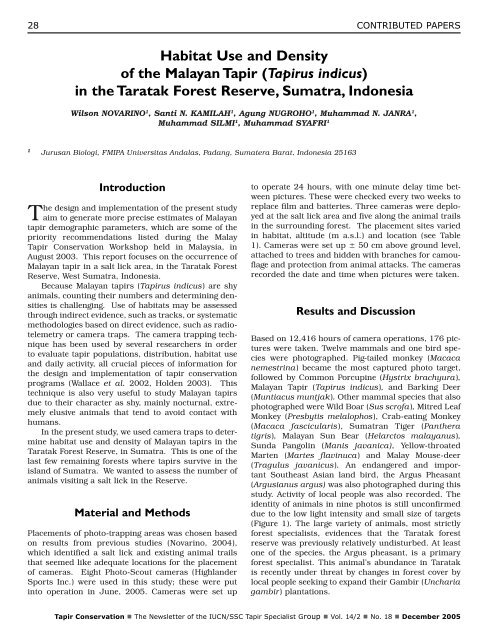Tapir Conservation - Tapir Specialist Group
Tapir Conservation - Tapir Specialist Group
Tapir Conservation - Tapir Specialist Group
You also want an ePaper? Increase the reach of your titles
YUMPU automatically turns print PDFs into web optimized ePapers that Google loves.
28<br />
Introduction<br />
The design and implementation of the present study<br />
aim to generate more precise estimates of Malayan<br />
tapir demographic parameters, which are some of the<br />
priority recommendations listed during the Malay<br />
<strong>Tapir</strong> <strong>Conservation</strong> Workshop held in Malaysia, in<br />
August 2003. This report focuses on the occurrence of<br />
Malayan tapir in a salt lick area, in the Taratak Forest<br />
Reserve, West Sumatra, Indonesia.<br />
Because Malayan tapirs (<strong>Tapir</strong>us indicus) are shy<br />
animals, counting their numbers and determining densities<br />
is challenging. Use of habitats may be assessed<br />
through indirect evidence, such as tracks, or systematic<br />
methodologies based on direct evidence, such as radiotelemetry<br />
or camera traps. The camera trapping technique<br />
has been used by several researchers in order<br />
to evaluate tapir populations, distribution, habitat use<br />
and daily activity, all crucial pieces of information for<br />
the design and implementation of tapir conservation<br />
programs (Wallace et al. 2002, Holden 2003). This<br />
technique is also very useful to study Malayan tapirs<br />
due to their character as shy, mainly nocturnal, extremely<br />
elusive animals that tend to avoid contact with<br />
humans.<br />
In the present study, we used camera traps to determine<br />
habitat use and density of Malayan tapirs in the<br />
Taratak Forest Reserve, in Sumatra. This is one of the<br />
last few remaining forests where tapirs survive in the<br />
island of Sumatra. We wanted to assess the number of<br />
animals visiting a salt lick in the Reserve.<br />
Material and Methods<br />
Placements of photo-trapping areas was chosen based<br />
on results from previous studies (Novarino, 2004),<br />
which identified a salt lick and existing animal trails<br />
that seemed like adequate locations for the placement<br />
of cameras. Eight Photo-Scout cameras (Highlander<br />
Sports Inc.) were used in this study; these were put<br />
into operation in June, 2005. Cameras were set up<br />
CONTRIBUTED PAPERS<br />
Habitat Use and Density<br />
of the Malayan <strong>Tapir</strong> (<strong>Tapir</strong>us indicus)<br />
in the Taratak Forest Reserve, Sumatra, Indonesia<br />
Wilson NOVARINO 1 , Santi N. KAMILAH 1 , Agung NUGROHO 1 , Muhammad N. JANRA 1 ,<br />
Muhammad SILMI 1 , Muhammad SYAFRI 1<br />
1 Jurusan Biologi, FMIPA Universitas Andalas, Padang, Sumatera Barat, Indonesia 25163<br />
to operate 24 hours, with one minute delay time between<br />
pictures. These were checked every two weeks to<br />
replace film and batteries. Three cameras were deployed<br />
at the salt lick area and five along the animal trails<br />
in the surrounding forest. The placement sites varied<br />
in habitat, altitude (m a.s.l.) and location (see Table<br />
1). Cameras were set up ± 50 cm above ground level,<br />
attached to trees and hidden with branches for camouflage<br />
and protection from animal attacks. The cameras<br />
recorded the date and time when pictures were taken.<br />
Results and Discussion<br />
Based on 12,416 hours of camera operations, 176 pictures<br />
were taken. Twelve mammals and one bird species<br />
were photographed. Pig-tailed monkey (Macaca<br />
nemestrina) became the most captured photo target,<br />
followed by Common Porcupine (Hystrix brachyura),<br />
Malayan <strong>Tapir</strong> (<strong>Tapir</strong>us indicus), and Barking Deer<br />
(Muntiacus muntjak). Other mammal species that also<br />
photographed were Wild Boar (Sus scrofa), Mitred Leaf<br />
Monkey (Presbytis melalophos), Crab-eating Monkey<br />
(Macaca fascicularis), Sumatran Tiger (Panthera<br />
tigris), Malayan Sun Bear (Helarctos malayanus),<br />
Sunda Pangolin (Manis javanica), Yellow-throated<br />
Marten (Martes flavinuca) and Malay Mouse-deer<br />
(Tragulus javanicus). An endangered and important<br />
Southeast Asian land bird, the Argus Pheasant<br />
(Argusianus argus) was also photographed during this<br />
study. Activity of local people was also recorded. The<br />
identity of animals in nine photos is still unconfirmed<br />
due to the low light intensity and small size of targets<br />
(Figure 1). The large variety of animals, most strictly<br />
forest specialists, evidences that the Taratak forest<br />
reserve was previously relatively undisturbed. At least<br />
one of the species, the Argus pheasant, is a primary<br />
forest specialist. This animal’s abundance in Taratak<br />
is recently under threat by changes in forest cover by<br />
local people seeking to expand their Gambir (Uncharia<br />
gambir) plantations.<br />
<strong>Tapir</strong> <strong>Conservation</strong> n The Newsletter of the IUCN/SSC <strong>Tapir</strong> <strong>Specialist</strong> <strong>Group</strong> n Vol. 14/2 n No. 18 n December 2005










